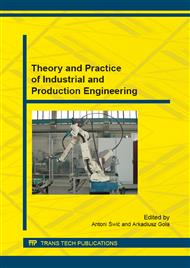[1]
M. Relich, A. Świć, A. Gola, A Knowledge-Based Approach to Product Concept Screening, Advances in Intelligent Systems and Computing, 373 (2015) 341-348, DOI: 10. 1007/978-3-319-19638-1_39.
DOI: 10.1007/978-3-319-19638-1_39
Google Scholar
[2]
Y. Koren, M. Shpitalni, Design of reconfigurable manufacturing systems, Journal of Manufacturing Systems, 29 (2010) 130-141.
DOI: 10.1016/j.jmsy.2011.01.001
Google Scholar
[3]
D. Plinta, D. Więcek, Production Systems Design, Wyd. Naukowe Akademii Techniczno-Humianistycznej, Bielsko-Biała, (2012).
Google Scholar
[4]
A. Gola, A. Świć, Computer-Aided Machine Tool Selection for Focused Flexibility Manufacturing Systems Using Economical Criteria, Actual Problems of Economics, 124, 10 (2011) 383-389.
Google Scholar
[5]
M. Hajduk, V. Baláž, L. Koukolová, J. Zubrzycki, Proposal of multi robotic cells for production lines, Applied Mechanics and Mathematics, 613 (2014) 60-65.
DOI: 10.4028/www.scientific.net/amm.613.60
Google Scholar
[6]
A. Gola, Economical Aspects of Manufacturing Systems Design, Actual Problems of Economics, 156, 6 (2014) 205-212.
Google Scholar
[7]
T. Tolio, M. Sacco, W. Terkaj, M. Urgo, Virtual Factory: an Integrated Framework for Manufacturing Systems Design and Analysis, Procedia CIRP, 7 (2013) 25-30.
DOI: 10.1016/j.procir.2013.05.005
Google Scholar
[8]
Y. Koren, The Golobal Manufacturing Revolution: Product-Process-Business Integration and Reconfigurable Systems, John Wiley & Sons, Inc, (2010).
Google Scholar
[9]
E. Abele, T. Liebeck, A. Worn, Measuring Flexibility in Investment Decisions for Manufacturing Systems, Annals of the CIRP, 55, 1 (2006) 433-436.
DOI: 10.1016/s0007-8506(07)60452-1
Google Scholar
[10]
J. A. Van Mieghem (1998). Investment strategies for flexible resources. Management Science, 44, 8 (1998) 1071-1078.
DOI: 10.1287/mnsc.44.8.1071
Google Scholar
[11]
A. Gola, A. Świć, Economical analysis of manufacturing systems configuration in the aspect of their productivity, Actual Problems of Economics, 162, 12 (2014) 385-394.
Google Scholar
[12]
F. M. Asl, A.G. Ulsoy, Stochastic Optimal Capacity Management in Reconfigurable Manufacturing Systems, Journal of Manufacturing Science and Production, 6, 1-2 (2004) 83-88.
DOI: 10.1515/ijmsp.2004.6.1-2.83
Google Scholar
[13]
S. M. Rocklin, A. Kashper, Capacity Expansion/Contraction of a Facility with Demand Augumentation Dynamics, Operation Research, 32, 1 (1984) 133-147.
DOI: 10.1287/opre.32.1.133
Google Scholar
[14]
O. Ceryan, Koren Y., Manufacturing capacity planning strategies, CIRP Annals – Manufacturing Technology, 58 (2009) 403-406.
DOI: 10.1016/j.cirp.2009.03.034
Google Scholar


